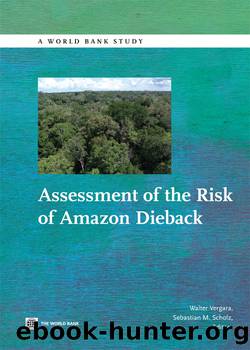Assessment of the Risk of Amazon Dieback by Walter Vergara & Sebastian M. Scholz

Author:Walter Vergara & Sebastian M. Scholz [Vergara, Walter; Scholz, Sebastian M.]
Language: eng
Format: epub
ISBN: 978-0-8213-8621-7
Publisher: The World Bank
Published: 2011-08-15T00:00:00+00:00
Changes in Transpiration
Another aspect of vegetation changes in the Amazon basin is the contribution of forest to the convective precipitation that plays an important role in the region for water supply (Malhi et al. 2008). Vegetation in Amazonia is dominated by tropical and mixed forests that maintain high transpiration rates of ~850 mm yr -1 (~2.3 mm d1) under current climate conditions, with annual precipitation of 1200â3000 mm and temperatures of 20â28°C. Figure 4.13 illustrates that tropical forests have a lower plasticity when it comes to accommodation to drier conditions. They remain only in areas with still high precipitation and maintain high transpiration rates. Mixed forests are able to adapt to drier conditions and their transpiration rates decrease under drier conditions and with higher temperatures. However, the ecosystem shifts toward degraded forest types with less forest cover and lower biomass, such as woodland and shrubs. These types transpire less and therefore reduce the contribution to convective precipitation.
Figure 4.13. Transpiration (in mm yr -1) for the Different Vegetation Types Is Dependent on Precipitation and Temperature
Download
This site does not store any files on its server. We only index and link to content provided by other sites. Please contact the content providers to delete copyright contents if any and email us, we'll remove relevant links or contents immediately.
| Automotive | Engineering |
| Transportation |
Whiskies Galore by Ian Buxton(41941)
Introduction to Aircraft Design (Cambridge Aerospace Series) by John P. Fielding(33095)
Small Unmanned Fixed-wing Aircraft Design by Andrew J. Keane Andras Sobester James P. Scanlan & András Sóbester & James P. Scanlan(32767)
Craft Beer for the Homebrewer by Michael Agnew(18200)
Turbulence by E. J. Noyes(7983)
The Complete Stick Figure Physics Tutorials by Allen Sarah(7339)
Kaplan MCAT General Chemistry Review by Kaplan(6903)
The Thirst by Nesbo Jo(6882)
Bad Blood by John Carreyrou(6584)
Modelling of Convective Heat and Mass Transfer in Rotating Flows by Igor V. Shevchuk(6408)
Learning SQL by Alan Beaulieu(6239)
Weapons of Math Destruction by Cathy O'Neil(6220)
Man-made Catastrophes and Risk Information Concealment by Dmitry Chernov & Didier Sornette(5958)
Digital Minimalism by Cal Newport;(5707)
Life 3.0: Being Human in the Age of Artificial Intelligence by Tegmark Max(5519)
iGen by Jean M. Twenge(5387)
Secrets of Antigravity Propulsion: Tesla, UFOs, and Classified Aerospace Technology by Ph.D. Paul A. Laviolette(5336)
Design of Trajectory Optimization Approach for Space Maneuver Vehicle Skip Entry Problems by Runqi Chai & Al Savvaris & Antonios Tsourdos & Senchun Chai(5040)
Pale Blue Dot by Carl Sagan(4960)
